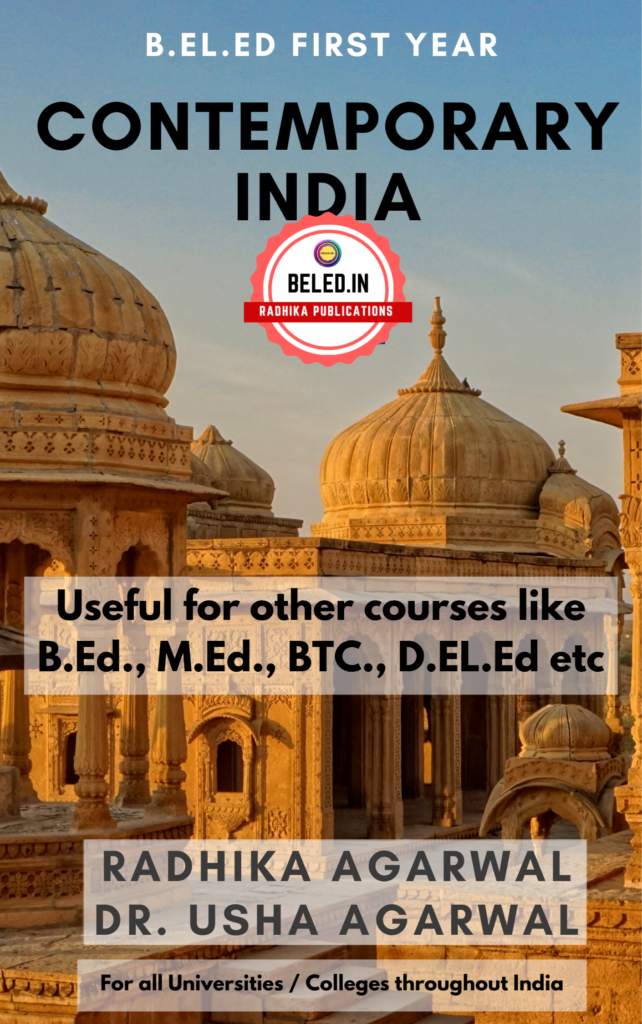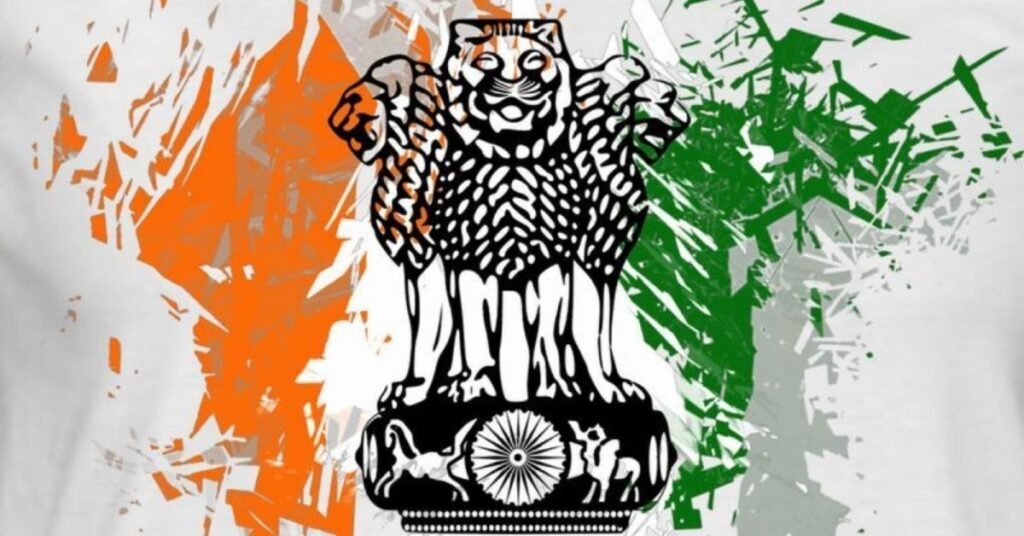STATE GOVERNMENT OF INDIA
In a federal form of government, the state government is the government of a country’s subdivisions and shares political power with the national government.
In the Constitution of India, which is a sovereign socialist secular democratic republic, the country has three levels of governments: the Central, the States and the Union Territories, besides the third level of governments, comprising the panchayats in rural areas and municipalities in urban areas. In India, the state governments are the level of government below the central government. Each state of the country is governed by the state government. At present, there are 28 state governments after the bifurcation of Jammu and Kashmir in our country, each of which is headed by the governor and the chief minister. The CM also heads the council of ministers.
B.EL.ED First Year Contemporary India Book

Five characteristics of the modern state:
The state is a recognizably separate institution or set of institutions, so differentiated from the rest of its society as to create identifiable public and private
The State is sovereign, or the supreme power, within its territory, and by definition the ultimate authority for all
The state’s sovereignty extends to all the individuals within a given territory, irrespective of formal positions held in the government or rule-making
The modern state’s personnel are mostly recruited and trained for management in a bureaucratic
The state has the capacity to extract monetary revenues (taxation) to finance its activities from its subject—population. All modem societies are nation-states, usually having some form of congressional or parliamentary system. A nation-state is a nation governed by a state whose authority coincides with the boundaries of the nation. Their system of government lays claim to specific territories, possesses formalized codes of law, and is backed by the control of military force.
Nation-states have come into existence generally after 19th century. The world today is largely organized into nation-states.
According to Giddens (1997), their main characteristics, viz., sovereignty, citizenship and nationalism, are discussed as under:
Sovereignty:
All nation-states are sovereign states. The notion of ‘sovereignty’ refers to the authority of a government over a clearly defined territory with clear cut borders, within which it is the supreme power.
Citizenship:
In modern societies most people living within the borders of the political system are citizens, having common rights and duties and knowing themselves to be part of a nation. Almost everyone in the world today is a member of a definite political order.
Nationalism:
Each community acquires a distinctive character through its association with nationalism. Nationalism can be defined as ‘a set of symbols and beliefs providing the sense of being part of a single political community’. Thus, individuals feel a sense of pride and belonging in being Indian, British, American, Russian or French. It is the main expression of feelings of identity with a distinct sovereign community.
Structure of the state government
Executive: State Executive comprises the governor and the chief minister with his council of Ministers. The Governor of each state is appointed by the President for a period of five years. Executive power of the state is vested in the governor. But the actual powers for proper functioning of the state are vested in the CM and his council of ministers.
Judiciary: State high courts have jurisdiction over the whole state. In the states, the judicial setup is headed by the chief justice. He manages and controls the entire judicial system of the state pertaining to criminal, civil and all other forms of litigation. State high courts have to, however, report to the Supreme Court of India, which may override the high court’s findings and judgements.
Legislature: Each state has a legislative assembly. It consists of the governor and one House or two Houses, as the case may be. In seven states, the state government’s legislature is bicameral. These states are Bihar, Andhra Pradesh, Telangana, Jammu and Kashmir, Karnataka, Maharashtra and Uttar Pradesh. These states have two Houses known as legislative council and legislative assembly. The rest of the states are unicameral. There is only one House known as legislative assembly. State Legislature or State Assemblies are headed by the CM.
Legislature has two division
Vidhan Parishad or Legislative Council
Vidhan Sabha or Legislative Assembly
VIDHAN PARISHAD
Also known as Upper
Like Rajya Sabha it is a permanent house and cannot be
Size cannot be more than 1/3 of the seats reserved for MLA’S.
Elected members called MLC (members of the legislative Council)
No MLC can be member of Cabinet of
Six years term with 1/ members retiring every two
Not more than one-third of total number of members or 40 members in legislative assembly of the state, except in J&K with 36
Elected by Governor, MLAs, standing graduates
VIDHAN SABHA
Also known in as lower
Fixed number of seats in lower
Different number of seats for different
Consists of not more than 500 members & not less than 60
Depends on the population of the
Consists of directly elected representatives (MLA) Members of legislative Assembly.
Chief Minister is the leader of the
MLA’S present in all state of India and in two of the Union
Selected MLAs are – Cabinet Ministers of the
Not more than 500 and not less than 60 members (an exception is the Legislative Assembly of Sikkim. It has 32 members)
Functions of State:
The state government is defined as the government of a country’s subdivisions and shares political power with the national government. In India, the state governments are the level of government below the central government. Each state of the country is governed by the state government.
Following are the roles and responsibilities of the state governments:
State governments have separate departments for efficient functioning of the state. States have jurisdiction over education, agriculture, public health, sanitation, hospitals and dispensaries and many other departments.
Internal security: The state governments have to maintain the internal security, law and order in the state. Internal security is managed through state police.
Public order: States have jurisdiction over police and public order.
Education: Providing a public education system, maintaining school buildings and colleges, employment of teachers, providing help to under privileged students all come under the education department of the state.
Agriculture: The state governments have to provide support for farmers, funds for best farming practices, disease prevention and aid during disasters such as floods or droughts.
Finances: State legislature handles the financial powers of the state, which include authorisation of all expenditure, taxation and borrowing by the state government. It has the power to originate money bills. It has control over taxes on entertainment and wealth, and sales tax.
Reservation of bills: The state governor may reserve any bill for the consideration of the President.
Transport: State government runs the trains, trams, bus and ferry services and other public transportation in the cities and towns of the States.
Water supply: Water supply to cities and towns for drinking, including irrigation for farmers, is the responsibility of the State governments.
Budget: State governments make budget for state.
Allocation of funds: It has the power to give funds to all its organizations like Zila Parishad, corporation, and other departments
General Powers of the State Government
The State Government shall have the power to issue policy directions on matters concerning electricity in the State including the overall planning and co-ordination. All policy directions shall be issued by the State Government consistent with the objects sought to be achieved by this Act and accordingly shall not adversely affect or interfere with the functions and powers of the Commission including but not limited to determination of the structure of tariffs for supply of electricity to various classes of consumers:
If any dispute arises between the Commission and the State Government as to whether or not a question is a matter of policy or whether a policy direction issued by the State Government adversely affects or interferes with the exercise of the functions of the Commission, the same shall be referred by the State Government to a retired judge of the Supreme Court in consultation with the Chief Justice of the Supreme Court whose decision thereon shall be final and
The State Government shall be entitled to issue policy directions concerning the subsidies to be allowed for supply of electricity to any class or classes of persons or in respect of any area in addition to the subsidies permitted by the Commission while regulating and approving the tariff structure provided that the State Government shall contribute the amount to compensate such concerned body or unit affected by the grant of the subsidies by the State Government to the extent of the subsidies granted. The Commission shall determine the amounts and the terms and conditions and time frame on which such amounts are to be paid by the State
The State Government shall consult the Commission in relation to any proposed legislation or rules concerning any policy direction and shall duly take into account the recommendation by the Commission on all such
- MJPRU B.El.Ed First Year Books, Syllabus, Question Papers & Question Banks (Hindi & English)“Looking for MJPRU B.El.Ed first-year resources? Explore a wide range of books, syllabus, question papers, and question banks in both Hindi and English for MJPRU B.El.Ed first-year students. Our comprehensive collection ensures access to the necessary study materials and aids to excel in your academic journey. Stay updated with the latest curriculum and prepare effectively … Read more
- CCSU beled Previous year Question Papers (For all years)इस Article में आपको beled के Previous Year Question Papers उपलब्ध कराये गए है। Chaudhary Charan Singh University बी.एल.एड विश्वविद्यालय के छात्रों के लिए महत्वपूर्ण है | आपको Video Guidelines एवं PDF’s दोनों मिल जाएंगे | To get all B.El.Ed News, Join Telegram Channel: – https://telegram.me/belednotes Youtube Channel:- https://www.youtube.com/c/Beledin Paying Thank to Mukul for Sharing … Read more
- Lucknow University beled question paper (For all years)इस Article में आपको beled के Previous Year Question Papers उपलब्ध कराये गए है। Lucknow University बी.एल.एड विश्वविद्यालय के छात्रों के लिए महत्वपूर्ण है | आपको Video Guidelines एवं PDF’s दोनों मिल जाएंगे | To get all B.El.Ed News, Join Telegram Channel: – https://telegram.me/belednotes Youtube Channel:- https://www.youtube.com/c/Beledin Paying Thank to Ram Prakash for Sharing Papers … Read more
- B.El.Ed Fourth Year Question Papers (For B.U, D.U, JNCU etc) | Hindi & EnglishTo get all B.El.Ed News, Free Notes, Join Telegram Channel: – https://telegram.me/belednotes Youtube Channel:- https://www.youtube.com/c/Beledin Curriculum Studies (पाठ्यक्रम अध्ययन) DOWNLOAD PDF:- https://drive.google.com/file/d/1mbU4wFoTBaQ1VZ8B0HuaWlZkiuPXlCn-/view?usp=sharing GENDER AND SCHOOLING (लिंग एवं विद्यायलय शिक्षा) Download Pdf:- https://drive.google.com/file/d/1KLhKI9z1ijwRbY2SnkYFItjxofgkc_M4/view?usp=sharing Special Education (विशिष्ट शिक्षा) DOWNLOAD PDF:- https://drive.google.com/file/d/10Y_saqHSXmxtg7tT-9Sj5VHFnikJ8YyE/view?usp=sharing PEDAGOGY OF LANGUAGE, MATHEMATICS AND SOCIAL SCIENCE PDF IS NOT AVAILABLE FOR THIS (YOU MAY … Read more
- Lesson Plans for B.El.ED, B.Ed, D.El.Ed studentsहम आपको प्रत्येक SUBJECT के लिए 10-10 Lesson Plan Provide कराएँगे | सारी जानकारी के लिए हमारे Youtube Channel को Subscribe करे और Pdf के लिए Telegram Channel Join Kare. Language Lesson Plan (Hindi, English and Sanskrit) Download Lesson plans
